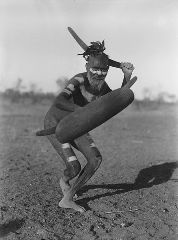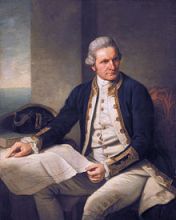History >> Geography >> Oceania >>
Australia
Australia
Timeline and History Overview
Australia Timeline

Aborigine
CE
- 1606 - The first European to land at Australia is Dutch explorer Captain Willem Janszoon.
- 1688 - English explorer William Dampier explores the western coast of Australia.
- 1770 - Captain James Cook lands at Botany Bay with his ship, the HMS Endeavour. He then proceeds to map the eastern coast of Australia, claiming it for Great Britain.
- 1788 - The first British settlement is established at Sydney by Captain Arthur Phillip. It is the start of the British penal colony which is made up of mostly prisoners.
- 1803 - Australia is proven to be an island when English navigator Matthew Flinders completes his sail around the island.

Captain James Cook
- 1808 - The Rum Rebellion occurs and the current governor, William Bligh, is arrested and removed from office.
- 1824 - The name of the island is changed from "New Holland" to "Australia."
- 1829 - The settlement of Perth is founded on the southwest coast. England lays claim to the entire continent of Australia.
- 1835 - The settlement of Port Phillip is established. It will later become the city of Melbourne.
- 1841 - New Zealand becomes its own colony separate from New South Wales.
- 1843 - The first elections are held for parliament.
- 1851 - Gold is discovered in the southeast region of Victoria. Prospectors flock to the area in the Victoria Gold Rush.
- 1854 - Miners rebel against the government in the Eureka Rebellion.
- 1859 - The rules for Australian rules football are officially written down.
- 1868 - Great Britain stops sending convicts to Australia. It is estimated that around 160,000 convicts were shipped to Australia between 1788 and 1868.
- 1880 - Folk hero Ned Kelly, sometimes called the Australian "Robin Hood", is executed for murder.
- 1883 - The railroad between Sydney and Melbourne opens.
- 1890 - The famous poem The Man from Snowy River is published by Banjo Paterson.
- 1901 - The Commonwealth of Australia is formed. Edmund Barton serves as the first Prime Minister of Australia. The Australian national flag is adopted.
- 1902 - Women are guaranteed the right to vote through the Franchise Act.
- 1911 - The city of Canberra is founded. It is named as the capital.
- 1914 - World War I begins. Australia fights on the side of the Allies and Great Britain.
- 1915 - Australian soldiers take part in the Gallipoli Campaign in Turkey.
- 1918 - World War I comes to an end.
- 1919 - Australia signs the Treaty of Versailles and joins the League of Nations.
- 1920 - Qantas airlines is founded.
- 1923 - The popular spread vegemite is first introduced.
- 1927 - Parliament is officially moved to the capital city of Canberra.
- 1932 - Construction is completed on the Sydney Harbour Bridge.
- 1939 - World War II begins. Australia joins on the side of the Allies.

Sydney Opera House
- 1942 - The Japanese begin air raids of Australia. The Japanese invasion is stopped at the Battle of the Coral Sea. Australian forces defeat the Japanese at the Battle of Milne Bay.
- 1945 - World War II comes to an end. Australia is a founding member of the United Nations.
- 1973 - The Sydney Opera House is opened.
- 1986 - Australia becomes fully independent from the United Kingdom.
- 2000 - The summer Olympics are held in Sydney.
- 2002 - Eighty-eight Australians are killed in the terrorist bombing of a nightclub in Bali.
- 2003 - Prime Minister John Howard receives a no-confidence vote from the Senate based on the Iraq crisis.
- 2004 - John Howard is elected to his fourth term as prime minister.
- 2006 - The country experiences extreme drought.
- 2008 - The government officially apologizes for previous treatment of the indigenous people including the "Lost Generation."
- 2010 - Julia Gillard is elected prime minister. She is the first woman to hold the office.
Brief Overview of the History of Australia
Australia was first inhabited perhaps 40,000 years ago by aboriginal peoples. During the Age of Exploration, the land was discovered and mapped by many Europeans including the Spanish, Dutch and English. However, Australia wasn't really explored until 1770 when Captain James Cook explored the east coast and claimed it for Great Britain. He named it New South Wales.

Mountains in Australia
The first colony was established at Sydney by Captain Arthur Phillip on January 26, 1788. It was initially considered a penal colony. This was because many of the first settlers were criminals. Britain would sometimes send their criminals to the penal colony rather than jail. Oftentimes, the crimes that people committed were small or even made up to get rid of unwanted citizens. Slowly, more and more of the settlers were not convicts. Sometimes you will still hear people refer to Australia as being started by a penal colony.
Six colonies were formed in Australia: New South Wales, 1788; Tasmania, 1825; Western Australia, 1829; South Australia, 1836; Victoria, 1851; and Queensland, 1859. These same colonies later became the states of the Australian Commonwealth.
On January 1, 1901 the British Government passed an act to create the Commonwealth of Australia. In 1911, the Northern Territory became part of the Commonwealth.
The first federal Parliament was opened at Melbourne in May 1901 by the Duke of York. Later, in 1927, the center of government and parliament moved to the city of Canberra. Australia took part in both World War I and World War II allied with Great Britain and the United States.
More Timelines for World Countries:
History >> Geography >> Oceania >>
Australia



